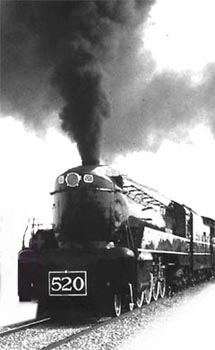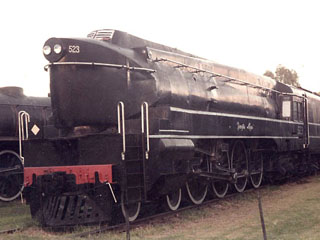
Photo courtesy Hank Meijer © copyright Hank & Linda's Web Pages |
"...waking the young from a dream, scattering like
glass - Judith Wright - extract from "the Trains" by Judith Wright; "Living Verse" A.K.Thomson, Jacaranda Publishers, Brisbane 1964 |
As World War II began, and the Great Depression finally lifted; traffic density on the railways escalated beyond their capacity, as the trains went "...North with guns." The South Australian Railways were faced with a shortage of mainline passenger power; that resulted in Berkshire and Mikado type freight locomotives of 4'9" driving wheel diameter working express passenger services.
Early in 1941, Chief Mechanical Engineer F.H.Harrison was handed the challenge of designing a general traffic locomotive with the power and speed of a heavy pacific; that was capable of operating over 60lb lines. The use of welding figured considerably among methods of keeping weight to a minimum. Harrison's original design included slightly heavier axle loadings than those of the final draft; which were modified to enable the locomotive to operate at higher speed over light plant.
Early designs envisaged a locomotive of more conventional appearance. Construction began, hampered by constant wartime materials shortage. Further refinement of the designs led to the inclusion of a streamlined exterior, Harrison considering a bullet -nosed boiler cladding, of Norfolk & Western "J" Class vain. The final inspiration for the streamlining came from Raymond Loewey in 1942, when the Chief Mechanical Engineer noticed an illustration of the Pennsylvania Railroad "T1" class 4-4-4-4, in a copy of the US magazine, "the Railway Age". On November 5th 1943, No.520 was named after the governer, Sir Malcom Barclay Harvey, who keenly admired the state's railways. The locomotive went on display at Adelaide Station for the next 2 days, entering service on November 10th.
Dynamometer Car tests demonstrated the exceptional performance of the class at speed, and indicated it's maximum power output of 2,600 hp at 70 m.p.h. Testing was considered very successful, during which 78 m.p.h was attained. The locomotives officially worked at speeds of up to 70 miles per hour over the section between Redhill & Pt.Pirie.
In 1968, whilst all broad guage steam locomotives in the state were being condemned; S.A.R Commissioner Ron Fitch agreed to retain certain locomotives for use by the Australian Railway Historical Society. No.526 "Duchess of Gloucester", was among the few; however problems with the inner firebox casing resulted in a regretful decision by the A.R.H.S to cease expenditure on the locomotive. No.520 was recommissioned in her place, being considered to be in better repair. Closer examination revealed however, that nothing short of a determined fund-raising effort would raise the sum required to restore the class leader to service.
The A.R.H.S learnt to be enterprising, seeking financial aid from whence it could; and late in January 1972 the S.A.R Islington workshops set about the task of rebuilding 520. On May 16th at 1 PM, driver Pat Brooks worked 520 "Sir Malcolm Barclay Harvey" from Adelaide to Sandy Creek and return with a 12 car train of 500 passengers; after 5 uncertain years in storage. The A.R.H.S continues to maintain 520 to this day, for use on it's highly recommendable trips through the Mt.Lofty Ranges to the Southern Ocean at Victor Harbour.
Locomotive No.523 the first to wear an updated version of the "T1" style streamling, is preserved under cover at the Port Dock Station Museum. Apart from my own, there are no plans to return this locomotive steam.
 Photo courtesy Rod Tonkin © copyright
Rod's Trains
Photo courtesy Rod Tonkin © copyright
Rod's Trains
General Data
Written by Robert Shaw
Steamranger
Port Dock Station Museum
| Auran Website | Database | Articles | Trainz Website |